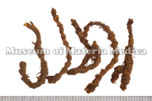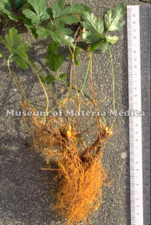Coptis Rhizome

|
Market name:黄連 Photo location:Museum of Materia Medica, Inst. of Nat. Med. TMPW No.:1252 |

|
Plant name:Coptis japonica var. japonica Photo location:Ishikawa Pref., Japan Photo date:1991 Photographer:K. Komatsu |
| Synonym | |
| Latin name | Coptidis Rhizoma |
| Botanical source: Family name | Ranunculaceae |
| Botanical source: Plant name | - Coptis japonica Makino (IPNI:710316-1) - Coptis chinensis Franchet (IPNI:710313-1) - Coptis deltoidea C.Y.Cheng et Hsiao - Coptis teeta Wallich (IPNI:710326-1) |
| Part used | Rhizome, from which the roots have been removed practically. |
| Empirical criteria for quality selection | Good one, which is deep yellow inside, is thick, firm and has a strong bitter taste. The rootlet has fibrous roots and less bitterness. It is lower quality (TN). |
| Constituents | Phenylpropanoids: Ferulic acid Isoquinoline alkaloids: Berberine, Palmatine, Jateorrhizine, Coptisine, Magnoflorine, Tetrahydropalmatine, Tetrahydroberberine, Worenine |
| Pharmacological effects | Antibacterial (broad antibacterial spectrum of berberine), constipation (berberine). |
| Indications | As an antiphlogistic amaroid stomachic and tranquilizer, it is applied to treat palpitation, mental instability, stuffiness of epigastrium, vomiting, diarrhea, stomachache and bleeding, accompanied with congestion or inflammation. |
| Diseases | Diarrhea, Full stomach, Vomitting, Feeling of pressure in the chest, Thirst, Oliguria, High fever, Disturbance of consciousness, Hematemesis, Nasal hemorrhage, Fret, Insomnia, Stomatitis, Toothache, Bleeding from root of tooth, Stomachache, Red eye, Swelling and pain of the throat, Pyogenic dermatosis, Tympanitis, Eye pain |
| Formulas | ireito , unseiin , untanto , oren'akyoto , orengedokuto , orento , kagenryokakusan (kyoteiken) , kakkon'oren'ogonto , kakkonkokato , kamiuntanto , kamigedokuto , kamishimotsuto , kankyooren'ogon'ninjinto , kanzoshashinto , keigairengyoto , saikanto , saikoseikanto , san'osan , san'oshashinto , shokankyoto , shokyoshashinto , jijinmeimokuto , jogan'ippo , jofuto , seijobofuto , senkanmeimokuto , daioorenshashinto , chikujountanto , nyoshinsan , hakutooto , hangeshashinto , bushishashinto , meiroin , yokukansankashakuyakuoren |
| Meridian tropism | Heart, Liver, Gall bladder, Stomach |
| Property | Cold |
| Flavor | Bitter |
| Classification in "Shen-non Ben-cao Jing" | Superior |
| TCM: Classification | Antipyretics (Drugs for elimination heat and dampness) |
| TCM: Medicinal effects | To remove damp heat, quench fire and counteract toxicity. Used for attack of damp heat manifested by a stuffiness and fullness sensation in the abdomen, vomiting, acute dysentery, jaundice, high fever accompanied by impairment of consciousness, fidgetness and insomnia due to exuberant fire, spitting of blood and epistaxis caused by heat in the blood, inflammation of the eye, acid regurgitation, toothache, diabetes, carbuncles and sores, external use for eczema and other skin disease with exudation, purulent discharge from the ear. |
| Remarks | Listed in the Japanese Pharmacopoeia 18th ed. Chinese Weilian is the rhizome of C. chinensis, Yalian is that of C.deltoidea C. Y. Cheng et Hsiao, Emeiyelian is that of C. omeiensis (Cheng) C. Y. Cheng, Yunlian is that of C. teeta Wall. subsp. lohitensis Pandit et Babu. Chinese mawielian is the subterranean part of Thalictrum species of family Ranunculaceae. |
| References | TN: T. Namba & Y. Tsuda ed., Outline of Pharmacognosy, a Textbook, 3rd ed., Nankodo Co., Ltd., Tokyo, 1998. |
DNA sequences of medicinal plants
| Gene Region | |||||||||||||||||||
| Nuclear | Chloroplast | Mitochondria | |||||||||||||||||
| Botanical source: Plant name | 5Ss | 18S | ITS1 | 5.8S | ITS2 | 26S | others | trnH-psbA | matK | trnK | trnK-rps16 | trnT-L | trnL | trnL-F | rbcL | rpoC1 | ndhF | others | |
|
|
|||||||||||||||||||
|
|
|||||||||||||||||||
|
|
|||||||||||||||||||
|
|
|||||||||||||||||||
